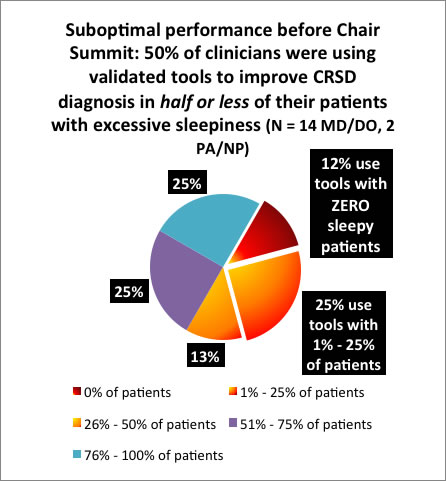Educational Outcomes: Outcomes Breaking New Reports
Preliminary Outcomes Report: Improving Accurate Diagnosis of Sleep-Wake Disorders at 6th Annual Chair Summit
Outcomes BLAST: CMEO reports a statistically significant change in use of measurement-based tools in the diagnosis of sleep-wake disorders
Chair Summit Sleep-Wake Track Learning Objective: To “regularly assess all patients for evidence of sleep-wake disturbances using validated screening questionnaires.”
A pre-activity survey gathered performance data from participating physicians, physician assistants, and nurse practitioners who affirmed that they see patients with excessive sleepiness, as follows:
- Before participating, 50.0% of participants were using validated laboratory tests, tools, and/or questionnaires to improve accurate diagnosis of CRSDs with less than half of their patients with excessive sleepiness, and 12.5% of this subset were using tools with none of these patients (n = 14 MD/DO, 2 PA/NP; see Figure).
- In a post-survey conducted over the five weeks after Chair Summit, 83.3% clinicians made strong commitments (ratings 4-5 of 5) to using validated diagnostic tools with their patients with excessive sleepiness (n = 12 MD/DO).
When physicians attending a small-group Breakout session at Chair Summit were asked in the post-survey how they would implement the use of diagnostic tools, open-ended responses included comments about increasing these: clinical suspicion for CRSDs (not just obstructive sleep apnea), use of assessment tools (Epworth scale or sleep diary), polysomnographic testing, referral rates, and patient education about sleep hygiene and sleep management. One outlined an immediate performance task: “[I] will use questionnaires with next 2 new patients.” 
Educational Impact
Clinicians outlined a variety of specific clinical actions they will immediately undertake in carrying out their commitment to using tools, demonstrating clinical competence and a good attitude toward change. Their commitments to using diagnostic tools to improve the accurate diagnosis CRSDs for patients with excessive sleepiness demonstrate that Chair Summit sleep education will help to narrow this large performance gap. Educating clinicians about CRSDs fills unmet needs to:
- Identify patients who need care for excessive sleepiness and who do not have the commonly suspected diagnosis of obstructive sleep apnea.
- Better understand how to use tools in evaluating sleepy patients.
- Implement early appropriate, multimodal treatment for patients with a diagnosed sleep-wake disorder.
Clinicians’ participation in a Breakout session on CRSDs indicates that they were self-selecting themselves for necessary education on sleep-wake disorders.
 Download Full Article
Download Full Article
This document was last modified on:







